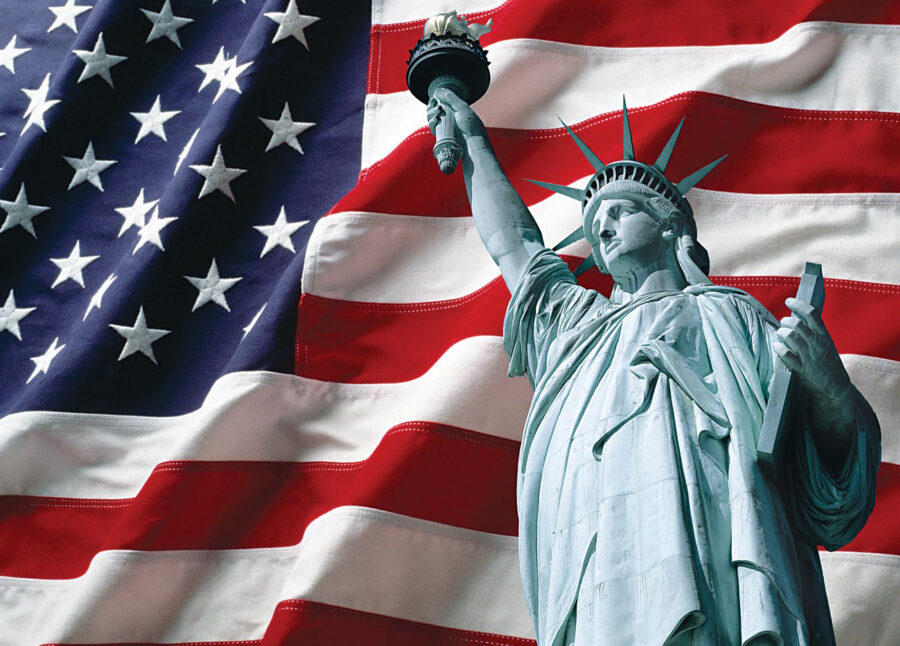A single work of art can flood the world with hope, wrap the human heart in the comforting warmth it longs for during uncertain times, and grant a nation a radiant emblem of freedom and democracy. That sensation wields an arresting power: it shapes our thoughts, guides the stories of our triumphs, and proves how deeply art is woven into the fabric of our lives. Rising as a triumphant testament to human ingenuity, the Statue of Liberty, a copper flame on the horizon reminds us of what creativity and shared spirit can achieve.
The ferry slips across the Hudson like a slow-moving mirror, gathering glints of sunrise while the skyline hovers behind in graphite and glass. Then, just beyond the bow, a jade-green figure materialises torch aloft, gaze unwavering seeming at once impossibly distant and intimately near. Since 28 October 1886 the Statue of Liberty has guarded the watery threshold of New York, her copper skin holding fast to ideals older than the republic whose harbour she adorns. What follows is an English re-imagining poised, expansive, and quietly impassioned of her turbulent genesis, her hidden anatomy, her shifting symbolism, and the visions that promise to ferry her into another century of relevance.

A Republican Giant Is Born
In the uneasy glow of post-Civil-War Paris, the legal scholar Édouard de Laboulaye proposed a monument “to freedom and to friendship.” His dinner-table remark ignited young sculptor Frédéric Auguste Bartholdi, who sketched that very night a titanic goddess stepping forward in mid-stride. While he refined the outward poise, Gustave Eiffel orchestrated an inner lattice of iron four spinal columns braced by thousands of riveted beams, airy yet unyielding without which the project would have remained a myth upon the drafting table.
Funding, meanwhile, spanned an ocean: French galas and art lotteries underwrote the statue; Joseph Pulitzer’s rousing editorials coaxed every last cent for the pedestal from American pickers. In the summer of 1885, 214 packing crates arrived aboard the transport ship Isère, and within four brisk months a copper colossus rose above the former Fort Wood, its torch already wired for the electric age.
An Engineering Marvel Beneath the Patina
Lady Liberty’s visage owes its weathered sea-foam hue to nothing more glamorous than time. Bare copper, a scant 2.4 millimetres thick, has oxidised into a protective dreamcoat of chrysocolla and malachite greens, nature’s own varnish. Beneath that luminous shell, Eiffel’s frame of puddled iron flexes almost imperceptibly in the harbour winds, absorbing storms that would crack a stiffer monument. Bronze saddles tether copper plates to iron ribs, allowing both metals to expand and contract in their separate rhythms. The torch, once ablaze with nineteenth-century arc lights, now houses LEDs that sip wattage yet blaze fiercely across the water after dusk, their brightness regulated by sensors attuned to passing fog and migrating birds.

The Pedestal’s Quiet Manifesto
Richard Morris Hunt devised the pedestal as a granite translation of classical proportion: tiered yet understated, free of dynastic crests or martial statuary. Where European triumphal arches flaunt emperors, Hunt embossed little more than laurels and shields symbols of civic virtue rather than conquest. Set into the stone, Emma Lazarus’s sonnet “The New Colossus” bequeaths an ethic of welcome, framing the statue less as trophy than as lighthouse. To read her verses is to sense how rhetoric can shift the destiny of bronze tethering a gift from France to the long, unsettled drama of American immigration.
An Ocean of Arrivals
From 1892 until 1954 more than twelve million souls sailed past Liberty Island on their way to the nearby examination halls of Ellis Island. Diaries describe a hush on deck when dawn’s first ray found the torch: hope froze into awe, the waves stilled by collective breath. Later memories admit a harsher counterpoint medical inspections, chalk marks on lapels, the heartbreak of separation. Yet even those narratives orbit Lady Liberty, using her outline as emotional compass. Novelists from Henry Roth to Colum McCann have returned to that moment of sighting, as though every American epic must negotiate the distance between torchlight and threshold.
A Stage for Protest
The statue’s dignified poise has not deterred dissent; rather, it has amplified it. Suffragists unfurled banners from her pedestal in 1917, demanding a vote that would not be granted for three more years. Anti-war veterans scaled the crown during the fraught summer of 1970. In 2018 a lone activist climbed onto the hem of Liberty’s copper robe to decry family separations at the southern border transforming a monumental foot into a pulpit for twenty-first-century conscience. Each ascent, each placard reminds the republic that liberty is never static, never fully achieved.

Within the Copper Arteries
A coveted crown ticket admits its bearer to 393 tight, wrought-iron steps spiralling upward through dusky light, the air tinged with mineral tang. Inspection portholes reveal the gap between skin and skeleton, emphasising how thin the threshold is between art and pure engineering. Crown windows twenty-five small ovals, each a scant handspan wide frame the harbour like an array of camera obscuras. Temperature in the shaft can oscillate by fifteen degrees Celsius in a single day; accordingly, sensors monitor strain and humidity, transmitting real-time data to park engineers before fatigue can turn to fracture.
The Museum of Memory
A glass-sheathed museum, opened in 2019, nestles into Liberty Island’s northern contour. The design sets turf-covered roofs against glimmering water, as though the building were an earthwork politely bowing to its elder neighbour. Inside, the original 1886 torch reigns in warm amber, its panes of glass mottled by a century of Atlantic breeze. A 360-degree film whisks visitors through the statue’s fabrication, trans-oceanic voyage, and inner scaffolding, while interactive kiosks weave visitor selfies into a living mosaic an ongoing portrait of all who make pilgrimage.

Conservation in the Anthropocene
Salt spray, acid rain, and the slow insurgence of the sea combine to threaten Liberty Island. The National Park Service has embarked on a multi-million-dollar rehabilitation of Fort Wood’s star-shaped terreplein, outfitting granite with hidden drainage channels and anti-icing membranes. Drone-mounted multispectral cameras now map micro-fissures invisible to the naked eye; the resulting “digital twin” feeds machine-learning models capable of predicting corrosion years in advance. Thus the monument’s past collaborates with algorithms to safeguard her future through an alliance of nineteenth-century metallurgy and twenty-first-century code.
Future Visions Sustainable, Inclusive, Immersive
Looking to the sesquicentennial of 2036, planners imagine Liberty Island powered chiefly by offshore solar arrays and tidal turbines. Engineers test transparent photovoltaic glass for the torch, a marriage of clarity and energy independence. Augmented-reality guides will allow visitors to superimpose historical tableaux onto present-day vistas: raise a phone, and Bartholdi’s Parisian workshop springs to holographic life amid the gulls and ferry horns. Accessibility, too, stands poised for transformation, with talk of a hydrogen-powered lift ascending inside the pedestal, its quiet glide embodying progress without disrupting the statue’s visual rhythm.
Global Reverberations
More than two hundred replicas scatter the globe, some marble, some neon yet none match the persuasive balance of grandeur and grace that animates the original. Contemporary artists disassemble her image to interrogate empire, migration, or surveillance. Ai Weiwei’s digital collage of Liberty borne on refugee rafts repositions the torch as beacon and burden; Danh Vo painstakingly reproduces isolated copper fragments, letting voids speak louder than mass. Each riff or provocation only reaffirms the strange vitality of the mother monument, whose symbolism adjusts like a lantern in shifting winds.
The Ethical Labour of Liberty
Beneath the sculptural calm lies unceasing effort. Park rangers patrol decks; materials scientists sample verdigris; genealogists tag Ellis Island manifests to blockchain archives. Activists urge that forthcoming restorations fund scholarships for climate migrants and legal-aid programmes for journalists, arguing that a statue representing freedom must invest in freedom tangibly. Political theorists cast Lady Liberty as a “perpetual project,” her outstretched arm less a conclusion than an invitation to unfinished work.
In the Hour before Dawn
On mornings when fog drifts in from the Atlantic, the torch seems to float untethered, a phosphorescent comma hanging between night and day. Cargo cranes along the New Jersey shore fall still, commuter trains hush on the Manhattan Bridge, and Liberty Island stirs awake. Conservators, students, tourists, and dreamers will soon mingle on those granite terraces, adding fresh syllables to a poem cast in metal yet endlessly revised in living memory.
For as long as people cross borders, question orthodoxies, and chase horizons, the Statue of Liberty will answer them with a radiant, wordless imperative: dare, care, and carry forward. Freedom, she insists, is not a prize upon a pedestal but an action renewed, ember by ember, in the human heart.
#StatueOfLiberty #LadyLiberty #AmericanIcon #SymbolOfFreedom #NewYorkHarbor #LibertyIsland #AmericanDream #PublicArt #CulturalHeritage #EllisIsland #CopperColossus #ArtHistory









